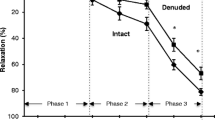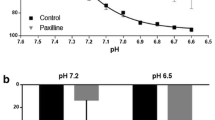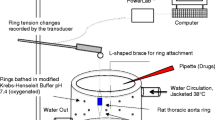Abstract
We examined the effects of various KCl concentrations on the actions of some vasodilators belonging to different pharmacological classes in rat aortic rings. In some experiments, tissues were precontracted with noradrenaline after blocking voltage-dependent channels to assess the effects of depolarisation unaccompanied by the entry of extracellular Ca2+ into the cytosol. Concentration/response curves for the vasorelaxant effect of calcium entry blockers (e.g. diltiazem), K+ channel openers (e.g. aprikalim), nitrate derivatives (e.g. nitroglycerin), a β2-adrenergic agonist (salbutamol) and papaverine were obtained by using endothelium-denuded rat aortic rings precontracted with KCl (20–60 mM) to determine the potencies and efficacies of the drugs. The efficacies and potencies of calcium entry inhibitors were virtually independent of the [KCl]. A reduction in the potency (up to 18-fold) of papaverine occurred without changes in efficacy when the [KCl] was raised from 20 to 60 mM. The decline in potency was even greater for nitrate-like compounds. The potency of K+ channel openers in aortic rings precontracted with 30 mM KCl decreased by three- to sixfold compared with those precontracted with 20 mM KCl. With the exception of pinacidil, the efficacy of these agents already started to decline in preparations precontracted with 25 mM KCl and was virtually zero in preparations precontracted with 60 mM KCl. In contrast to other K+ channel openers, the vasorelaxant action of pinacidil was relatively resistant to glibenclamide. Salbutamol produced only a slight relaxation even in preparations precontracted with 20 mM KCl. In nitrendipine-pretreated, noradrenaline-precontracted aortic rings, the vasorelaxant effects of aprikalim, but not those of linsidomine or papaverine, declined when the [KCl] of the bathing medium was increased. In conclusion, the vasorelaxant potency and efficacy of calcium entry blockers is independent of the [KCl] used to precontract rat aortic rings, and thus, of the degree of membrane depolarisation. In contrast, increasing the [KCl] strongly reduces the potency and the efficacy of K+ channel openers not only in this preparation but also in noradrenaline-precontracted rings in which the entry of extracellular Ca2+ was prevented with nitrendipine. This indicates that, with the exception of pinacidil, the vasorelaxant activity of K+ channel openers depends on the degree of membrane depolarisation. Finally, the vasorelaxant potency and efficacy of nitrate-like compounds and papaverine are independent of depolarisation per se but they are markedly affected by the influx of Ca2+ accompanying elevated [KCl]. Thus, the degree of vessel depolarisation should be taken into consideration when attempting to compare potencies and efficacies among vasorelaxant agents.
Similar content being viewed by others
Author information
Authors and Affiliations
Additional information
Received: 4 May 1998 / Accepted: 6 July 1998
Rights and permissions
About this article
Cite this article
Magnon, M., Calderone, V., Floch, A. et al. Influence of depolarization on vasorelaxant potency and efficacy of Ca2+ entry blockers, K+ channel openers, nitrate derivatives, salbutamol and papaverine in rat aortic rings. Naunyn-Schmiedeberg's Arch Pharmacol 358, 452–463 (1998). https://doi.org/10.1007/PL00005278
Issue Date:
DOI: https://doi.org/10.1007/PL00005278




